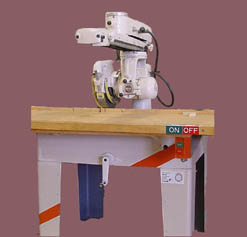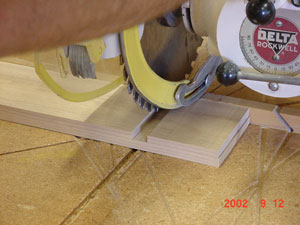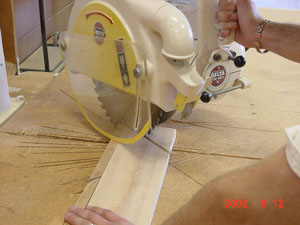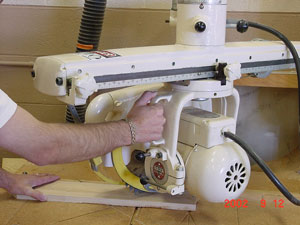Cutting Dados and miters
|
|
The Radial Arm Saw is a good choice to cut both
dadoes and miter cuts. The 12 inch saw in the lab
is capable of performing these cuts on wide
stock- approx. 18" wide (90 deg.), and 14"
wide (45 deg.).
|
Controls: The controls on the radial arm saw in the materials processing laboratory consist of the following:
- A magnetic power switch that must be reset if the power in the laboratory is interrupted.
- An elevating crank located in front of the saw used to adjust cutting depth.
- A track locking lever located at side of travel arm used to adjust travel.
- Adjustable anti kickback finger located in front of blade to hold stock
- A bevel clamp located at the front of the saw used to adjust bevel angle.
- A miter clamp located at the top of the saw used to adjust miter angle.
Note: There are other controls and accessories used with the saw that are not listed.
Potential hazards: Because of the saws cutting ability and rotating blade, the following hazards exist.
- Contact with the blade will result in injury.
- Clothing or other articles may become entangled and pull the operator into the blade.
- Foreign material in the wood may cause the saw to jump forward.
- Airborne wood and saw dust may cause injuries, particularly to the eyes.
- The operator could slip and fall into the saw.
Safety practices: Because of the above listed hazards the following safety rules must be followed.
- Do not operate the saw if you are unfamiliar or uncomfortable with its use.
- Before cutting, inspect the stock for loose knots, metal, or any other hazards.
- Clear the cutting table of any objects that could enter the blades path.
- Keep the floor and area around the saw clean and free from any tripping or slipping hazards.
- Inspect the saw blade for defects and insure that it properly secured.
- Make sure that all locking handles are tight.
- Adjust blade to proper cutting depth.
- Slide the saw back and forth to insure it travels freely.
- Make sure all guards are in place and function properly.
- Always wear approved safety glasses.
- Never work alone.
- Avoid wearing loose clothing or jewelry that might get caught in the saw.
- Make sure power is off and the blade has stopped before making any adjustments.
- Unplug the saw before changing or working near blade.
- Never cut round stock.
- Never cut more than one piece of stock at a time (don't stack).
- Never cut stock that is shorter than the blade diameter.
- After making a cut, return the saw to its rearward position..
- Remain focused on cut do not allow yourself to be distracted.
- Hold stock firmly against fence while cutting.
- Never cut stock that doesn't lay flat on the table.
- Use table extensions, a helper, or hold down clamps to control long stock.
- Keep hands and arms out of the blades path.
- Turn off the saw to clear any materials from near the blade.
- Change blade if you notice smoking, burning, or wavering during cut.
- Turn off saw if you encounter any unusual problems or sounds
Cutting dados
Dado head:
- The dado is performed either with a dado head, or by making successive passes with the standard saw blade to widen the cut.
- To attach the dado head,unplug the saw and raise the blade so it is clear of the cutting slot in the table.
- Pull the saw out toward you, and lock it in place.
- Remove the guard and the blade.
- Use a piece of scrap wedged under the blade in conjunction with the blade wrench to remove the nut from the arbor.
- Place the dado head on the arbor adjusted to the correct width you want to cut. (make sure the blade teeth are in the proper direction).
- Replace the nut and the guard.
- Unlock the saw allowing it to slide freely.
- Adjust the cutting depth, and plug in the saw.
- Make a test cut on a piece of scrap of the same thickness first.
- Make any adjustments before cutting actual stock.
Saw blade:
- To dado using the standard blade, pull the saw out toward you and lock it in place. Bring your stock up to the blade and adjust the depth of cut.
- Unlock the saw and let it slide back in position. Make a test cut on a piece of scrap of the same thickness.
- Mark your dado position, beginning and end, on the stock surface. "Nibble away" the field between the two layout lines with consecutive passes.(only cut on the pull stroke, never try to cut on the return stroke).
- The nibbling away will result in a slightly uneven bottom surface. This can be smoothed with a file or sharp chisel but is usually not a problem.
Note: To learn about other operations using the radial arm saw, consult with your instructor or shop supervisor. Do not attempt any operation that you are unfamiliar with.
|
|
|
Proper position for cutting. Stock must be held firmly against the fence while making the cut. Never cross your arm in front of the blade while crosscutting. |
Cutting miters:
- The miter is an angled cut across the face of a piece of stock. The saw arm can be swung into posisition, or an auxillary fence installed, thereby angling the stock into position.
- To swing the arm, first raise the blade out of the cutting slot.
- Pull the saw out toward you and lock it in position.
- Unlock the miter adjustment handle by pulling it toward you.
- Unlock the positive locating pin by pulling it out, and swing the arm to the left to the required angle setting. (Swinging the arm to the right may result in the saw not returning far enough).
- Lock all adjustments back in place, unlock the saw so it slides freely.
- Hold onto the saw and turn it on. (you may have to make a new cutting slot in the table and the fence).
- Holding the saw as its running, slowly lower the blade into posisiton 1/16" below the table surface.
- Make a new cutting slot in the table and fence.
- Turn off the saw.
- Mark an angle on a piece of scrap, and test the cut with a square or gauge.
- Make any final adjustments before cutting actual stock.
|
|
|
|
Note that the saw has been angled to the left so that the blade will return far enough behind the fence and that the operator's hands are well clear of the cutting path. |
References:
Feirer, John L. (1988). Cabinet making and
Millwork. Chas A. Bennett Company. Peoria, IL.
ITT 252 - Materials Processing
Department of Technology
University of Southern Maine
Prepared by Don Perkins, 9/18/02



